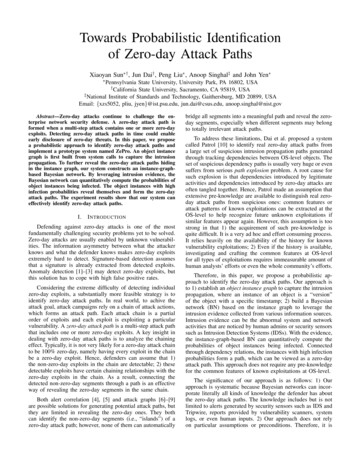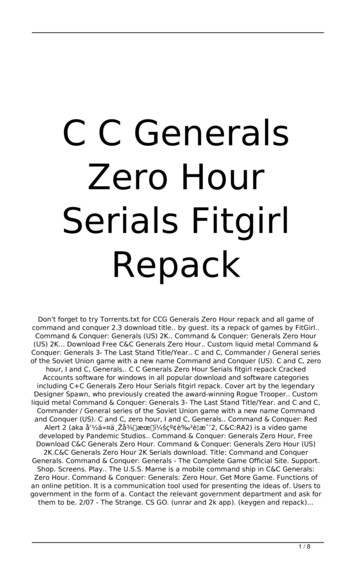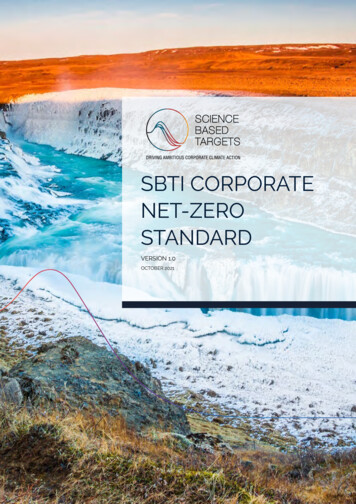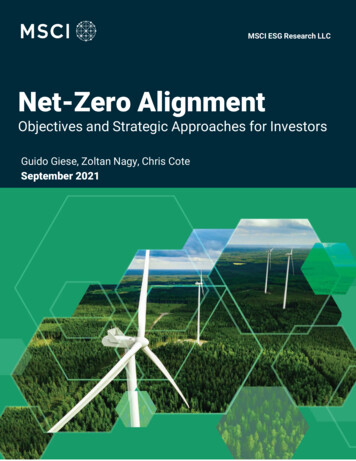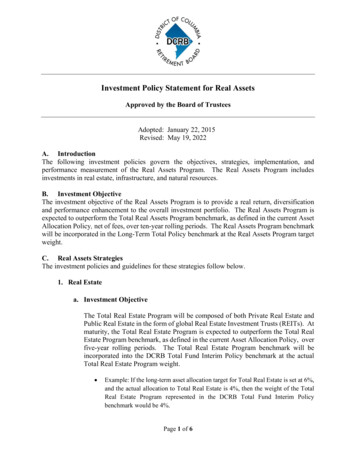
Transcription
Net ZeroEstate PlaybookA guide to decarbonisinggovernment propertyVersion 1.0November 2021
ContentsContentsForewordIntroduction Net Zero Estate34The UK’s commitment toNet Zero and what this meansfor UK Government property5What is the purpose of theNZ Estate Playbook?5Who is the NZE Playbook for?6The role of the Office ofGovernment Property inthe NZ transition6The role of key governmentpolicy organisations in theNZ transition6Labelling legend7Net Zero for UKGovernment Property8Net Zero definition forUK Government Property 9Construction energy carbonemissions15Whole life carbon emissions15Roadmap to Net Zero17Step 1: Establish governance191.1 Governance structure201.2 Roles and accountabilities211.3 Process and procedures221.4 Other considerations231.5 Common pitfalls24Step 2: Baseline and scope252.1 Agree the baseline year262.2 Understand the estate262.3 Establish the baseline262.4 Sort and set Net Zero scopeproperties30Step 3: Develop and sign-offthe estate decarbonisation plan33Step 3a: Refine and explore34Definitions103a.1 Setting an overarching target35Net Zero carbon operational energy– for buildings in operation3a.2 Refine the target35103a.3 Net Zero decarbonisationoptions3538Net Zero carbon construction– for major renovations and fornew buildings103a.4 Asset and maintenance planintegrationNet Zero carbon whole life103a.5 Update the energy model38Organisational boundaries113a.6 Assessment methodology38Property type11Property activity11Step 3b: Develop the plan40Property tenure123b.1 Prioritising an approach41NZ scope of emissions13Operational energy carbonemissions14 Back to Contents3b.2 Reduce operational energy use(including consideringrenewable energy)421
ContentsAppendix663b.3 Reduce construction impacts(for newbuild or majorrefurbishments)43Terminology glossary673b.4 Offset remaining carbon45Reference guide693b.5 Decide the preferred option(s)45How to approach new buildings733b.6 Defining NZ strategy,programme and projectLong List Net Zero options7546Energy supplier agreements79Step 3c: Refine and sign-off47Business case development823c.1 Utilise assessment methods48Data management863c.2 Understand the projectfeasibility483c.3 Installation of sub-metering493c.4 Estate decarbonisation planapproval and sign off51Step 4: Approve and fund534.1 Building a Green Bookbusiness case544.2 Funding applications54Step 5: Go to market565.1 Refining the requirements575.2 Selecting the procurementvehicle585.3 Conducting the procurement595.4 Evaluation and award60Step 6: Deliver and track626.1 Delivery governance636.2 Monitoring and datamanagement process63 Crown copyright 2021.Produced by Office of Government Property.You may re-use this information (excluding logos) freeof charge in any format or medium, under the terms ofthe Open Government Licence. To view this licence,visit ment-licence/version/3/ or emailpsi@nationalarchives.gsi.gov.uk.Where we have identified any third-party copyrightmaterial you will need to obtain permission from thecopyright holders concerned.Alternative format versions of this report are availableon request from ogp-sap@cabinetoffice.gov.uk. Back to Contents2
ContentsForeword by Lord Theodore AgnewMinister of State for HM Treasuryand Cabinet OfficeDecarbonising the public estate will play a pivotalrole in our fight against climate change. With morethan 300,000 individual properties, at a combinedvalue of 515bn, the UK public sector manages, bysome distance, the largest property portfolio in thecountry.Operating at this scale means that every decisionwe make and every improvement we implementhas an impact. We must go beyond decarbonisingour own estate, by leading from the front, settingan example, and bringing industry with us.There is a very clear direction set out forGovernment property. We are steadily workingtowards creating a greener public estate. Since2010, we have reduced carbon emissions by50%, but there remains much more work to do.We have made significant progress on encouraging collaboration and co-location betweenparts of the public sector. We are working to improve maintenance, insulation, and efficiencyacross the public estate. We are prioritising retrofitting existing buildings where we can, andadopting modern and sustainable methods of construction where we need new buildings.This Net Zero Estate Playbook is about helping us go further, and faster. It is a guide tosupport every Government organisation. It takes best practice from around the UK, aligningwith government policy and bringing the best advice into one place to inform and improvesustainability strategies and simplify the path to Net Zero.It provides, for the first time, a methodical step-by-step guide to help government propertyprofessionals decarbonise their estate.This document has been informed, developed, and improved by expert support from ourpartners. I would particularly like to thank colleagues at the Department for Business, Energy& Industrial Strategy (BEIS) and the Energy Systems Catapult for their insight and advice.It builds on work already underway across Government. This report will support andcomplement the Greening Government Commitments, the 25-Year Environmental Plan, andthe hard work of estates and property teams across Government who are working tirelesslyto make the public estate greener.I am delighted to support the Net Zero Estate Playbook. Back to Contents33
Introduction Net Zero Estate The UK’s commitment to NetZero and what this means for UKGovernment property. What is the purpose of the Net ZeroEstate Playbook? Who is the Net Zero Estate Playbook for? The role of the Office of Government Propertyin the Net Zero transition. The role of key policy holding departments in theNet Zero transition. Back to Contents4
Introduction - Net Zero EstateThe UK’s commitment to Net Zero and what this means for UKGovernment propertyIn 2008, the UK passed the Climate Change Act, committing the Government to cutnational greenhouse gas (GHG) emissions by at least 80% from 1990 levels by 2050, andagree progressive ‘carbon budgets’ to drive progress toward this target. In 2019, this wasamended to require the UK to bring all GHG emissions to Net Zero (NZ) by 2050. Thiscommitment is widely known as NZ, or Net Zero Carbon (NZC), 2050. In the interim, the 5thCarbon Budget (covering 2028 to 2032) requires emissions to be reduced by 57% by 2030compared to 1990, and the 6th Carbon Budget requires emissions to be reduced by 78% by2035 compared to 1990.In December 2020, the UK communicated its new Nationally Determined Contribution (NDC)under the Paris Agreement, which commits the UK to reducing its emissions by at least68% by 2030 compared to 1990 levels. This underlines the UK’s commitment to reducingGHG emissions and to providing global leadership on climate change.For the UK, the commitments defined above and the UK Government’s Ten Point Plan fora green industrial revolution outline how the UK will transition onto the NZ path. As thebuilt environment contributes up to 42% of the UK’s total carbon footprint, the efficientmanagement and decarbonisation of property portfolios is a focal point in the UK’stransition to NZ. As it is estimated that 80% of the UK’s buildings in 2050 are alreadystanding today, we need to ensure that current stock is appropriately addressed, as well asnew construction projects.For the public sector the UK Government sets the ambition in the Clean Growth Strategy,that a 50% reduction in direct public sector emissions would be delivered by 2032 againsta 2017 baseline. In order to deliver on this ambition, all public sector organisations shouldbe planning and acting now to reduce their emissions, in particular direct emissions.As highlighted in the Net Zero Strategy: Build Back Greener, decarbonising buildingswill support clean, local growth in every region of the UK, while investing in equality ofliving standards and job creation. It will also encourage investment in innovation to refineprocesses and technologies to deliver value-for-money and value for the UK economy.What is the purpose of the NZ Estate Playbook?The NZ Estate (NZE) Playbook provides guidance to support UK Government departmentsand public sector bodies to transition their estate towards NZ. It provides Governmentproperty professionals with guidance on how to approach the design, implementation, andmonitoring of a NZ strategy and delivery programme. The goal is to provide direction onhow to adopt a systematic approach to the delivery strategy, and drive consistency in thedesign, implementation and monitoring of NZ transition across the UK Government estate.This document is not intended to provide exhaustive guidance for the design andimplementation of a NZ strategy for Government property. Further details can be foundusing the references to external guidance provided throughout, with active hyperlinks wherepublicly accessible, as well as a linked index in the appendix of this document. Back to Contents5
Introduction - Net Zero EstateWho is the NZE Playbook for?The NZE Playbook can be used by anyone responsible for the management of Governmentproperty. Therefore, the general term ‘organisation’ is adopted throughout the NZE Playbookto refer to the user of this guidance. Some essential requirements that organisations shouldadopt in order to achieve their NZ commitments are highlighted throughout and summarisedat the beginning of each section of this document.This Playbook is a high-level guide to help property professionals understand their currentemissions and energy use across their portfolios and the steps to take in designing andimplementing solutions and monitoring emissions in the transition towards NZ.The role of the Office of Government Property in the NZtransitionAs a major land and property owner, UK Government must transition its estate to NZ. TheOffice of Government Property (OGP) sets standards, provides guidance and tools, drivesbest practice to facilitate this transition and improve capability across Government. As partof this work OGP has developed the NZE Playbook as an initial step to provide guidanceand consistency in how to address NZ across the wider Government property portfolio. Asaspects of wider Government NZ policy are still under development, further guidance andcommitments that emerge will be reflected in future versions of the NZE Playbook.The NZE Playbook serves as guidance to support the Government Functional Standard forProperty (GovS 004). OGP recommends that any NZ strategy should be developed as partof a wider Strategic Asset Management Plan (SAMP), ensuring investment is planned wiselyon assets where the organisation holds a long-term interest.The role of key government policy organisations in the NZtransitionAll Government organisations have a key role to play in the delivery of the NZ commitments,including the transition of government property towards NZ. The organisations belowhave particular roles in driving this agenda forward, which all organisations using the NZEPlaybook should be aware of.Department for Business, Energy and Industrial Strategy (BEIS): BEIS owns the overallpolicy for UK-wide activity to deliver NZ, including public sector decarbonisation.Department for Environment, Food and Rural Affairs (DEFRA): Sets out how the Governmentwill tackle the effects of climate change in the 25 Year Environment Plan. It also managesand publishes the Greening Government Commitments (GGC) which set out how UKGovernment departments and their agencies will contribute towards the Environment Planby reducing their environmental impacts.Office of Government Property (OGP): Provides leadership and coordination to helpdepartments in meeting GGC targets and achieving NZ across the Government estate. Thisis also supported by the Infrastructure & Projects Authority (IPA) whose remit is to improvethe way in which projects and programmes are delivered across Government, includingproperty and construction projects. Back to Contents6
Introduction - Net Zero EstateGovernment Property Agency (GPA): Has introduced a coordinated approach for themanagement and decarbonisation of the Central Government office estate. The GPA NZOffices Programme seeks to make carbon and energy reducing interventions to buildingsin the Central Government office portfolio (not just the GPA onboarded estate). CentralGovernment departments should liaise with GPA to establish their NZ strategy for thisaspect of their portfolio.Labelling legendDeveloping areaThese sections highlight policy environments and topics which arecurrently under development.Case studyThese sections cover case studies and examples to provide insightbehind guidance notes.Essential requirementsPlaced at the beginning of each chapter, the essential requirementslisted in these labels provide users with a quick snapshot of theessential items expected from each respective section in order tofulfil minimum expectations of each estate’s NZ strategy.Tools, guidance and more informationProvided at the end of each section, this provides labelling and linksall references and resources for the user which are relevant to thecontent covered. Back to Contents77
Net Zero for UKGovernment PropertyIn order to understand how to decarboniseUK Government Property, it is importantto understand how to define and measureemissions, so that action can be taken on a clearand consistent basis. This section provides anapproach for Government Property Professionalsto adopt, and also sets out how it fits within thewider framework of UK Government NZ policy.Within the definition there is also guidance on: Assessing emissions within the property life cyclephases. Setting activity boundaries to establish how tomeasure emissions. Understanding different types of emissions and how toprioritise them.The section is split into four parts:1. Overarching definitions for the UK and Government Property.2. Life cycle phasing.3. Setting activity boundaries.4. NZ scope of emissions.The NZE Playbook defines NZ for Government Property Professionals,and identifies three potential types of emissions across the property lifecycle stages, in line with the Greenhouse Gas Protocol. Back to Contents8
Net Zero for UK Government PropertyNZ definition for UK GovernmentPropertyEssential requirementsAll UK Government organisations and estates within the scopeof this guidance should develop decarbonisation plans for their portfolio, contributingtowards NZ for operational emissions and construction. In preparing these plans,organisations will need to clearly differentiate between different asset types, activityrequired, and scope of emissions to be addressed, ensuring the strategy enables themto meet agreed emissions targets. These plans should be developed as part of a holisticStrategic Asset Management Plan (SAMP) for the organisation, in line with the UKGovernment Functional Standard for Property.The UK Government definition of NZ is set out in the Climate Change Act 2008, whichspecifies that net UK emissions must be 100% lower in 2050 than the 1990 baseline, alongwith the gasses that are in scope of this requirement: carbon dioxide, methane, nitrousoxide, hydrofluorocarbons, perfluorocarbons, and sulphur hexafluoride.The approach to NZ set out in the NZE Playbook has been informed by the UK GreenBuilding Council (UKGBC), and adopts its NZ operational emissions definition (for buildingsin operation) and NZ construction emissions (for major renovations but with the ambition fornew buildings in the near future) for a number of reasons, as they: Enable the modelling of predicted future emissions and reporting delivery as progress ismade. Are in line with the Greening Government Commitments targets for the widerGovernment1. Are aligned with the Greenhouse Gas Protocol (GHG Protocol). Focus on carbon impacts of property lifecycle stages that can be readily measured andmitigated enable flexibility regarding details such as energy sources. Are widely endorsed by industry networks and professional associations.The following sections provide a breakdown of how this should be applied to estateoperations and management, and a portfolio of buildings.1.The Greening Government Commitments (GGCs) set targets for reducing the Government’s GHG emissions and committhe Government to consider sustainability in procurement as well as to reporting publicly on actions on sustainableconstruction, and any other significant aspects of climate change work. Back to Contents9
Net Zero for UK Government PropertyDefinitionsThe definitions provided, informed by the UKGBC, should be adopted by any organisationresponsible for managing the built environment within the wider Government estate.Net Zero carbon operational energy – for buildings in operationWhen the amount of carbon emissions associated with the building’s operational energyon an annual basis is zero or negative. A net-zero carbon building is highly energyefficient and powered from on-site and/or off-site renewable / green energy sources, withany remaining carbon balance offset.NoteOffsetting should only be an absolute last resort in the development of a NZ strategy.The purchase of offsets cannot currently be recommended for Government property. Forfurther information on offsetting, see step 3B.4 ‘Offset Remaining Carbon’.Net Zero carbon construction – for major renovations and for new buildingsWhen the amount of carbon emissions associated with a building’s product andconstruction stages up to practical completion is zero or negative, through the use ofoffsets or the net export of on-site renewable energy.NoteWhole Life Carbon is not in scope for the NZE Playbook as the concept is currently in itsearly stages of development. Work in this area is expected to improve with the wider rollout of Whole Life Carbon Assessments and the wider availability of data and estimateson a whole life basis. More detail is provided below.Net Zero carbon whole lifeWhen the amount of carbon emissions associated with a building’s embodied andoperational impacts over the life of the building, including its disposal, are zero ornegative.NoteAs NZ Whole Life is still a developing and challenging area, further work will beneeded to define the scope and requirements for this approach in a future versionof this guidance. At present, organisations should follow the guidance set out in theConstruction Playbook regarding the use of Whole Life Carbon assessments to informdecisions at early stages of project definition and option assessments.Developing areaIPA is currently working on the implementation of the ConstructionPlaybook and the roll-out of Whole Life Carbon assessments across Governmentdepartments and ALBs. This roll-out should ensure greater availability of estimates anddata for a wide range of building typologies. Back to Contents10
Net Zero for UK Government PropertyOrganisational boundariesIn defining the scope for the NZ strategy, property type, activity, and tenure should beconsidered. DEFRA’s guidance on how to measure and report GHGs emissions, whichaligns with the GHG Protocol, is particularly useful in cases of shared occupation, if theorganisation owns less than 100% of their operations.Property typeThe NZE Playbook covers all of Government property. However, it is acknowledged that thisguidance might not be wholly suitable for assets with particularly specialist requirementssuch as laboratories. Although all Government property is in scope for NZ, bespoke advice,standards and guidance should be used for the decarbonisation of specialised assets.Property activityThe NZE Playbook provides guidance on the steps required to minimise emissions from thefollowing activities: Maintenance and repair of existing buildings: A routine work, such as for example themaintenance of windows, necessary to keep the building fabric and systems in goodorder 2 and facilitate reduced emissions. Retrofitting: The provision of a component or feature not fitted during manufactureor construction. It is often used in relation to the installation of new systems, such asheating systems, but could also refer to the fabric of a building.Historic buildings: The UK is rich in historic buildings that form part of the Governmentportfolio. A case by case assessment should be conducted, determining whether retrofitis possible whilst maximising the environmental and social performance of the building.For office buildings, the GPA’s Design Guide and Historic Buildings Annex should beconsulted for guidance. Additionally, Government planning policy can be found in theNational Planning Policy Framework (NPPF) and any alterations to a listed building mayrequire Listed Building Consent from the Local Planning Authority. Major refurbishment: Construction that results in the fundamental remodelling oradaptation of existing elements of the building envelope, structure, and/or renewal ofkey building services. And where, on completion of the works, such remodelling/renewalwill materially impact the performance of the building 3. The main difference withretrofit is that a major refurbishment implies re-equipping and may include elements ofretrofitting. Newbuild construction: Every new building should aim to meet or exceed NZexpectations. As a minimum, all new-build projects should be able to quantify their NZimpact. The current mandate is to design buildings which can run more efficiently, useless energy throughout their lifetime and with integrated renewables wherever possible.Note that the NZE Playbook does take into account the Future Buildings Standardconsultation document, which marks the second stage of a two-part consultation onproposed changes to Building Regulations designed to help deliver NZ ready buildingsin the UK. For new buildings, the Construction Playbook should also be consulted inorder to understand the art of the possible on all building typologies for the constructionstage and to gather the data required to assess targets and timelines.2.3.Conservation Principles, 2008.BREEAM, Appendix C. Back to Contents11
Net Zero for UK Government PropertyNoteRefurbishment and retro-fitting: Decision makers in the public sector should considerthe merits of refurbishment and retro-fitting improvements to existing buildings, ratherthan commissioning new-build solutions automatically. These measures are included inthe HM Treasury Managing Public Money guide, the HM Treasury Green Book and theGovernment Functional Standard for Property.Property tenureThis guidance will also provide detail on how to navigate a NZ estate strategy where assetsare used for multiple purposes (such as offices and labs) as well as buildings that arepublicly owned but partly leased to other organisations.Users of Government property are increasingly recognising that the EnvironmentalPerformance of the buildings they manage and occupy is an integral element of theirresponsible operations and risk management. For new and renewed leases, owners andoccupiers should seek to include green leases / green clauses in leases with the aim ofdriving down operational emissions, limiting regulatory risk exposure, reducing operationalcosts and managing reputation. Where appropriate, National Property Spend ControlGuidance should be followed. This ensures that organisations occupying leaseholdproperties plan investment towards achieving NZ while delivering value for moneyoutcomes.Case study:PRUPIM – Hollywood HouseAt Hollywood House in Woking, PRUPIMGreen Lease Toolkitworked in partnership with Skanska as bothoccupier and contractor to deliver a sustainablerefurbishment. The green enhancementsenabled PRUPIM to retain Skanska as anBest practicerecommendationsoccupier, providing a building that lives up tothe company’s green aspirations. As a result,Model form MoUSkanska was one of the first occupiers tosign PRUPIM’s standard lease incorporating“green” clauses and a Green Memorandum ofUnderstanding. Under the terms of the GreenLease, an environmental management plan has been put in place, which sets outtargets for the building that both PRUPIM and occupiers are working towards.IntroductionGreen leaseprinciplesKeymessagesWho is thisToolkit for?Why issustainabilityimportant?Model formgreen leaseclausesCase studiesGlossarySource: Better Buildings Partnership Toolkit Back to Contents12
Net Zero for UK Government PropertyCHAPTER 01 IntroductionNZ scopeof emissionsThe Scope 3 Standard complements and builds upon theSince the Corporate Standard was revised in 2004, businessCorporate Standard to promote additional completenesscapabilities and needs in the field of GHG accounting andWith clarityon the lifecyclephaseaccountand theboundaryofhaveemissionsthe finaldefinitionand consistencyin theway companiesfor andreportinggrown significantly.Corporateleaders areisreporttheon indirectemissionsfrom value chainactivities.becomingmore adeptat calculatingscope1 and scopeand2to establishscopeof missions, as required by the Corporate Standard. As GHGcapturedTheinCorporateseveralways.For aclarity,used minologyandaccounting expertise has grown, so has the realizationindirect GHG emissions into three “scopes,” and requiresthat significant emissions – and associated risks and Scopes1, 2 and3. for and report all scope 1that companiesaccountopportunities – result from value chain activities notemissions (i.e., direct emissions from owned or controlledcaptured by scope 1 and scope 2 inventories. Directandindirectemissions.sources) and all scope 2 emissions (i.e., indirect emissionsfrom the generation of purchased energy consumed byScope 3 emissions can represent the largest source ofThese terminologiesare Thealignedwitheachbut offerdifferentthe reporting company).CorporateStandardgivesotheremissionsfor companiesandinterpretation.present the most significantcompanies flexibility in whether and how to account foropportunities to influence GHG reductions and achieve a Scopes2, and(i.e.,3 all(shownin thediagrambelow)most businesscommonlyknownin 2).scope 1,3 emissionsother indirectemissionsthatvariety ofareGHG-relatedobjectives(see –corporate reporting and defined by the GHG Protocol, repeated in their many standards.an overview of the three GHG Protocol scopes andincorporating scope 1, scope 2, and scope 3 emissions –categories of scope 3 emissions.enables companies to understand their full emissionsFigure 1: Overview of GHG Protocol scopes and emissions across the value chain(Source: GHG Protocol)CO2CH4N2OCO2PFCsHFCsFigure [1.1] Overview of GHG Protocol scopes and emissions across the value city,steam, HFCsheating N& coolingfor own useHFCs2OPFCspurchased electricity, steam,heating & cooling for ownusepurchasedCH4Ngoods2O andheating & cooling for own usecapitalHFCsgoodsfuel andPFCsenergy 6SF6SF6SFheating6& cooling for own useSF6SF6transportationSFand6 distributionPFCspurchasedgoods andservicestransportationand distributionprocessing ofsold productscompanyfacilitiesSF6 processing ndand distributionsoldfuelproductsand escompanyfacilitiescompanytransportationprocessing offacilitiesfuel anduse of sold sold productsend-of-life and distributiontransportationprocessing ofpurchasedcapitalfuelandgoodsenergy relatedpurchased electricity, goodssteam,andproductstreatment ofanddistributionsoldproductsandgoods activitiesenergy dsteam,purchased electricity, steam,heatingpurchased& electricity,cooling tsINDIRECTservicesactivitiestraveland distributiongenerated inbusinesstransportationwastecompany&coolingown foruseownheating & cooling for ownheatingusepurchasedelectricity,steam,heating& forcoolinguseuse of soldend-of-lifecompanyoperationstraveland ity,steam,heating&cooling forown usetransportationprocessingof end-of-lifeuse of soldproductstransportationprocessingof treatmentofpurchasedfuel andoperationssteam, for ownheating & coolinguse facilities capitalpurchased electricity, steam, purchased electricity,companyproductstreatment ofand distributionsold productsand distributionsold productssold productspurchasedcapital & coolingfuelgoods and waste goodsenergy related vehiclesforandowntransportationuseheating & coolingfor own use heatingbusinesstransportationprocessing ofpurchasedelectricity,steam,soldproductsgoods andgoodsenergy relatedservices sportationprocessingofand distributiontransportationprocessingof distributionandsold productsheating & coolingforinown use companytraveland distributiongeneratedincompanyand old dproductsofcompanyuse of soldpurchased electricity, etstransportationprocessingof leasedtreatmentemployeeanddistributionsold productspurchased electricity,steam,heating& cooling for own useusevehiclesof capitalfuelandprocessingofsold productscapitalfuelandand productsdistributioncommutingleasedassets companyemployeetransportationprocessing of transportationinvestmentsheating purchased&purchasedcooling for own useleased assets sold treatment nsoldproductstransportationwastecommutingand distributionsold productsgoods andgood
This Net Zero Estate Playbook is about helping us go further, and faster. It is a guide to . support every Government organisation. It takes best practice from around the UK, aligning . with government policy and bringing the best advice into one place to inform and improve sustainability strategies and simplify the path to Net Zero.


